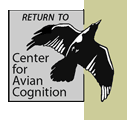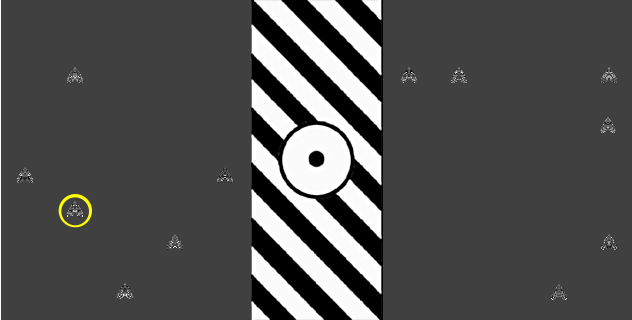


Cuing and Priming
To shift attention from one searching image to another, birds often rely on contextual stimuli to figure out what to search for next. Multiple established templates may be stored in long-term memory, waiting for some linked stimulus to call one of them up and make it the center of attention. In lab experiments, human subjects remember the visual features of the most recently detected target and use them as the template for a searching image. It is called repetition priming. (Kristjánsson & Campana, 2010). Priming of attention by the last detected target is similarly common in avian visual search (Pietrewicz & Kamil 1979, Blough 1989, 1991, Langley et al. 1996, Bond & Kamil 1998, Bond & Kamil 1999), where it is most apparent when targets are difficult to detect, diverse in appearance, and displayed on complex, textured backgrounds (Bond & Kamil 2002, Bond & Kamil 2006, Bond 2007).
But searching images can also be activated by an associative cue, an otherwise arbitrary stimulus that is correlated with the occurrence of the target. The cue does not need to have a physical resemblance to the sought-for item. For James Bond, even just the verbal description of his target fish could suffice to deploy a searching image (Fleming 1960). Cuing has long been the primary method for manipulating attention in human visual search studies. Instructing a subject to watch for a green “T” in the next display, for example, cues her attentional focus to a particular combination of shape and color and causes distracting alternatives to be ignored. This process depends on semantic memory for the association between the cuing stimulus (i.e., the words “green T”) and the visual features of the target (Wolfe 1998, Chun 2000).
Associative cuing also seems to play a role in birds, especially when their previous searching image has faded due to lack of reinforcement. There is observational evidence suggesting that birds use previous successful foraging at a given location or the color or texture of the substrate to determine what type of prey should be sought (Heinrich & Collins 1983, Krebs et al. 1974, Getty & Pulliam 1991, 1993). One of the best examples is from Croze's (1970) field study of foraging in wild carrion crows. Croze scattered red-painted mussel shells, each covering a small piece of meat, on natural areas of ocean beach. The local crows rapidly learned to search for them and flip them over. When the crows were subsequently offered painted red shells of other kinds -- like razor clams or cockles -- the birds investigated them in areas where they had previously found rewarding red mussels. But in other locations, novel red shells were often overlooked, suggesting that features of the familiar foraging site may have specifically cued a search for red targets. The inference is tempting, but any account of a cognitive mechanism requires careful experimental designs to exclude alternative explanations, and associative cuing has been hard to demonstrate under fully controlled conditions (Blough 1989, Belik 2002).
The strongest form of the visual template hypothesis assumes that essentially the same cognitive representation can be elicited by any sufficiently predictive stimulus (Langley 1996, Bravo & Farid 2009, 2012), ranging from the location of previous foraging successes, to the shape of a tree leaf, to the appearance of a prey item that had just been found and eaten. So a foraging bird that noticed insect damage on the new leaves of an oak tree might activate the same searching image as another bird that had just finished feeding on an oak-leaf caterpillar. There is, however, a strong distinction between repetition priming and associative cuing. Cuing is produced not by the appearance of the target itself, but by stimuli that are secondarily reinforced by having been associated with a prior prey detection. If a bird has found a caterpillar on a leaf of a particular shape, it may later recognize the same shape on a different leaf and use the association as a cue to a focused attentional search. The effect of secondary reinforcement, however, fades rapidly the longer the time delay between a currently perceived stimulus and the last relevant prey capture. Priming, in contrast, is the immediate consequence of detecting and eating a prey item and is based on stimulus features that are intrinsic to the prey. This close proximity between the prey stimulus and the food reward in priming should have a stronger, longer-lasting effect than associative cuing. Given the diversity of influences that can determine which template is chosen, it is essential to consider whether cuing and priming operate in the same fashion -- whether they really do elicit exactly the same searching image -- and whether it is possible for them to interfere with one another.
Cuing and Priming ExperimentTo test for the effectiveness of cuing versus priming and to look for interaction effects when both are present, we trained blue jays to search for digital moths (about the size of a housefly) on a computer touchscreen (Goto, Bond, Burks & Kamil 2014). Because the individual birds varied widely in how well they could detect these targets, we needed to be able to adjust the task difficulty for each jay to insure equivalent performance. We adopted Blough’s (1989, 1991) discrimination design, which presents targets and comparable distractors on a visually flat background against which all stimuli are clearly visible. Our targets were maximally distinctive from one another, while maintaining a sufficient resemblance to the distractors to make discrimination challenging.
During initial training, each bird was taught a specific set of four rewarded targets. In each detection trial, one of these targets was displayed among a varying set of similar distractors. The figure above shows a sample display with a target (circled here in yellow) and eleven distractors in the side panels. The central panel served as a cue strip that provided information about what target to expect in the trial. In this illustration, the cue strip is shown in black with diagonal lines, which is equally associated with two of the four targets. It is, thus, an ambiguous cue that does not specify which of the two targets to look for. Informative cue strips that predicted a single specific target type were either in red with vertical lines or green with horizontal lines. The cue strip was displayed just before the stimulus array was shown and turned off during the actual search, thereby maintaining the characteristic time relationship: associative cues in nature generally precede the initiation of a search. We elicited repetition priming by presenting uniform blocks of trials with an ambiguous cue, but a single target type, and we contrasted those results with trials in which targets were presented in randomized order. Test sessions included trials with stimuli that were 1) either correctly or incorrectly cued; 2) either primed or unprimed; 3) both cued and primed; or 4) neither cued nor primed. To control for effects from prior training, the study was divided into two successive phases -- one with and one without repetition priming. Combining all sessions within subjects across both study phases yielded a full experimental design, enabling us to evaluate the relative effects of priming and cuing and to determine the nature of their interaction in combined treatments.
Initial training was accelerated by priming -- the birds learned much more rapidly in treatment sessions where the same target was repeated in successive trials. Learning was significantly slowed when targets were both cued and primed, however, suggesting that the two processes interfered with each other during training. When the birds were fully trained, attentional effects showed up mainly when the target was not the focus of the current searching template: Response time was higher in miscued trials during cuing sessions, and accuracy was lower on primed trials following an unexpected target switch. A combination of both cuing and priming greatly interfered with detection in unexpected trials, apparently a result of the limited capacity of working memory, which insures that only one searching image can be deployed at a time.
During initial training, the birds learned the characteristic features of all four of their target types. Two targets were uniquely associated with particular colored cues; the other two were both associated with the same noncolored cue. At the start of each trial, therefore, the bird probably had available in long-term memory a representation of each of the possible targets. The issue is how these representations interacted in generating the searching image. Unlike human subjects in laboratory studies, animals have to learn the significance of the cue from repeated successful discoveries, so associative cuing in a natural environment can readily be disrupted by variation in the abundance and appearance of the different target types. The evidence in our experiment of interference between cuing and priming during both training and testing makes it seem unlikely that these two processes can ever simultaneously contribute to a real-world visual search in animals.
Cuing may only work well when the food items are not that difficult to see and are reliably detected when present. It would also help if the target stimuli were distinctive from one another and limited in diversity. And of course, the cues themselves would need to be highly predictive of eventual reward. Coincidentally, these are precisely the conditions in which repetition priming is least useful and least likely to show a significant effect (Bond 1983, 2007; Bond & Kamil 1999). Situations in which both forms of attentional guidance operate at the same time are, therefore, unlikely to be common in nature. What seems more probable is a sequence of actions in which cuing or priming operate at different stages of the same search. So cues from the location of a tree or the appearance of its leaves might attract a foraging bird and direct its attention to particular branches. If the prey items are cryptically colored, repetition priming would then become paramount, enhancing the success of subsequent detections. Visual search is an inherently hierarchical activity (Curio, 1976), and there is reason to expect different kinds of attentional guidance to dominate at different points in the process.
Additional discussion of this issue can be found in our review article (Kamil & Bond 2006), and the whole concept of visual search in animals is placed in a broader context in our book, Concealing Coloration in Animals, published in 2013 by Harvard U. Press.
References from Other Sources
Blough, P.M. (1989). Attentional priming and search images in pigeons. Journal of Experimental Psychology: Animal Behavior Processes 15: 358–365.
Blough, P.M. (1991). Selective attention and search images in pigeons. Journal of Experimental Psychology: Animal Behavior Processes 17: 292–298.
Bravo, M.J., & Farid, H. (2009). The specificity of the search template. Journal of Vision 9: 1–9.
Bravo, M.J., & Farid, H. (2012). Task demands determine the specificity of the search template. Attention, Perception, & Psychophysics 74: 124–131.
Chun, M. M. (2000). Contextual cuing of visual attention. Trends in Cognitive Sciences 4: 170–178.
Croze, H. J. (1970). Searching image in carrion crows. Zeitschrift für Tierpsychologie Supplement 5: 1-85.
Curio E. (1976). The Ethology of Predation. Berlin: Springer-Verlag.
Fleming, I. (1960). For Your Eyes Only. London: Jonathan Cape.
Getty, T, & Pulliam, H.R. (1991). Random prey detection with pause-travel search. American Naturalist 138: 1459-1477.
Getty, T, & Pulliam, H.R. (1993). Search and prey detection by foraging sparrows. Ecology 74: 734-742.
Heinrich, B., & Collins, S.L. (1983). Caterpillar leaf damage and the game of hide-and-seek with birds. Ecology 64: 592-602.
Krebs, J.R., Ryan, J.C., & Charnov, E.L. (1974). Hunting by expectation or optimal foraging? A study of patch use by chickadees. Animal Behaviour 22: 953-964.
Kristjánsson, Á. and G. Campana. (2010). Where perception meets memory: A review of repetition priming in visual search tasks. Attention, Perception, & Psychophysics 72: 5-18.
Langley, C. M. (1996). Search images: Selective attention to specific visual features of prey. Journal of Experimental Psychology: Animal Behavior Processes 22: 152-163.
Wolfe, J.M. (1998). Visual search. In H. Pashler (Ed.), Attention (pp. 13–73). Hove, East Sussex: Psychology Press.



